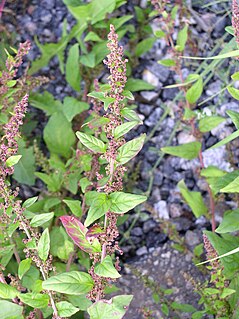
Blitum bonus-henricus, also called Good-King-Henry, poor-man's asparagus, perennial goosefoot, Lincolnshire spinach, Markery, English mercury, or mercury goosefoot, is a species of goosefoot which is native to much of central and southern Europe.

The Chenopodioideae are a subfamily of the flowering plant family Amaranthaceae in the APG III system, which is largely based on molecular phylogeny, but were included - together with other subfamilies - in family Chenopodiaceae in the Cronquist system. Food species comprise Spinach, Good King Henry, several Chenopodium species, Orache, and Epazote.

Chenopodium is a genus of numerous species of perennial or annual herbaceous flowering plants known as the goosefoots, which occur almost anywhere in the world. It is placed in the family Amaranthaceae in the APG II system; older classification systems, notably the widely used Cronquist system, separate it and its relatives as Chenopodiaceae, but this leaves the rest of the Amaranthaceae polyphyletic. However, among the Amaranthaceae, the genus Chenopodium is the namesake member of the subfamily Chenopodioideae.

Atriplex paludosa, commonly known as Marsh Saltbush, is a species of saltbush endemic to Australia.
Atriplex paludosa subsp. baudinii is subspecies of Atriplex paludosa that is endemic to Western Australia.

Chenopodium candolleanum, commonly known as seaberry saltbush, is a shrub in the subfamily Chenopodioideae of the family Amaranthaceae, native to Australia.
Chenopodium benthamii is a species of shrub endemic to midwest Western Australia.

Tecticornia halocnemoides, commonly known as Shrubby Samphire or Grey Glasswort, is a species of succulent, salt tolerant plant endemic to Australia. It grows as a spreading or erect shrub up to fifty centimetres high. It was first published as Arthrocnemum halocnemoides in 1845, but transferred into Halosarcia in 1980, and into Tecticornia in 2007.

Oxybasis chenopodioides, is a species of flowering plant in the amaranth family known by the common name low goosefoot.

Chenopodium nutans, known by its common name of climbing saltbush or nodding saltbush, is a climbing groundcover native to Australia.

Chenopodium robertianum, known by the common name of saloop or berry saltbush is a small plant in the family Amaranthaceae. This species is found in coastal and inland areas of eastern Australia. Occasionally seen in rainforest gullies, though mostly seen in more open areas.

The Betoideae are a small subfamily of the flowering plant amaranth family, Amaranthaceae sensu lato. Commonly known members include beet, sugar beet, chard, and mangelwurzel, which all are cultivars of Beta vulgaris.

Dysphania is a plant genus in the family Amaranthaceae, distributed worldwide from the tropics and subtropics to warm-temperate regions.

Oxybasis glauca, common name oak-leaved goosefoot, is a species of goosefoot plant native to Europe. It has been introduced and become an invasive weed in North America. This invader of European origin also appears in trampled communities in North Korea.

Chenopodium parabolicum, commonly known as fragrant saltbush or mealy saltbush, is a shrub in the family Amaranthaceae. The species is native to Australia.

Chenopodiastrum is a genus of herbaceous flowering plants in the family Amaranthaceae. The genus was formally described in 2012. The 5 species occur in Eurasia, North Africa, and North America.

Blitum is a genus of flowering plants in the amaranth family Amaranthaceae, subfamily Chenopodioideae. It is closely related to genus Spinacia. Its 12 species were traditionally placed in the genera Chenopodium, Monolepis, or Scleroblitum. The species of genus Blitum occur in Asia, Europe, North Africa, the Americas, and Australia.

Oxybasis is a flowering plant genus from the subfamily Chenopodioideae in the family Amaranthaceae. It was first described in 1841, and newly used since 2012 for five species that were traditionally grouped into genus Chenopodium. They occur in Europe, Asia, North Africa and America.

Lipandra polysperma, common name manyseed goosefoot, is the only species of the monotypic plant genus Lipandra from the subfamily Chenopodioideae in the family Amaranthaceae.

Chenopodium spinescens is a species of plant in the amaranth family, endemic to Australia. It is found in all states and territories of Australia with the exception of Tasmania.
















